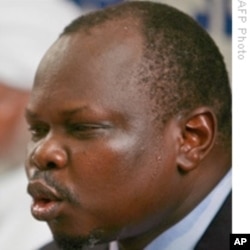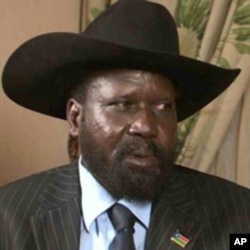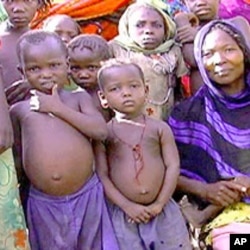This week, the president of the Government of Southern Sudan, Salva Kiir, named a new 32-member cabinet. Observers say it’s a mixture of old and new. Among the officials who have been replaced is Dor. Joseph Minytuil Wiejang, former Minister of Health, and former minister of Housing and Physical Planning, Martin Okerrok.
Seven of the ministers are women, and the National Congress Party has two posts - the ministries of wildlife and tourism, and of the environment.
A focus on the future
In the most publicized move, the secretary general of the ruling Sudan People’s Liberation Movement, Pagan Amum, was named to head the Ministry of Peace and CPA Implementation. In the post, he’ll negotiate with officials of the central government in Khartoum over issues that must be settled before a planned referendum in January over independence for the south.
Sudan analyst Hussein Solomon of the Institute of Islamic Studies in Pretoria, South Africa, said he has some concerns about the cabinet move.
“[Amum] is a bit of a hot head, and you don’t need someone to add further fuel to the fire, and he’ll be liaising with his counterpart[s] up north.
“But I understand why Kiir appointed him: Given his position [in the SPLM], the party and the Government of Southern Sudan wanted to keep [the implementation of the comprehensive peace agreement and the referendum] as very important issues. So making use of the [SPLM] secretary general in that [new cabinet] position does make sense.
Inroads for women
Another well-known official named to the cabinet is Anne Itto, the SPLM deputy secretary general for the southern sector. She’s been named to head the Ministry of Cooperatives and Rural Development, a post that Solomon says “is important in that you have a [major problem in south Sudan] in terms of food security. She is a bit of a technocrat, which is good; and does not seem to be ideological. She is one of seven cabinet ministers who are female, but I don’t know to what extent she is regarded as a heavy hitter for such an important post.”
The Sudan analyst says Kiir is keeping with his campaign promise to have women make up almost 30% of his cabinet. The move is also in keeping with the comprehensive peace agreement signed between the north and south, which suggested that women should make up at least 25% of government.
“It’s going to be a process,” says Solomon. “It’s not enough, but given the patriarchal culture he’s operating in, [Kiir] should be commended.”
Bigger...or better ?
Some complain that the cabinet is too big, and could be cut in half. Salva Kiir’s challenger in the recent presidential election, Dr. Lam Akol Ajawin, calls it bloated, and some positions redundant. Others say the staffing is based on political considerations, instead of providing service to constituents.
Analyst Hussein Solomon says “there are some who say it is unwieldy, but it was a fine balancing act. Kiir did succeed in retaining those with sets of skills who were performing well in the previous cabinet, and getting rid of dead wood like the former Minister of Health [Joseph Minytuil Wiejang] if you consider the strikes in the medical sector. There was also geographic representation, though to what extent it represents adequately an ethnic representation, I’m not sure of that.
“But what I find most interesting,” he explains, “is that the southern Sudan Legislative Assembly did endorse all of Kiir’s cabinet posts …After the elections, Kiir took two months to assemble the cabinet [which] is broadly representative of all the major factions in the SPLM and other political parties. [That] suggests he has finally gotten control and established his authority.








